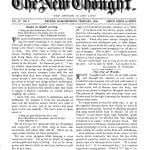 First off, congratulations to Besse Cooper on reaching her 115th birthday!
First off, congratulations to Besse Cooper on reaching her 115th birthday!
Excellent piece on John Polkinghorne by Dean Nelson.”Likewise, Polkinghorne doesn’t know for sure that there is a God. And yet, when he was at the top of his game in physics at Cambridge in 1979, he left the laboratory studying one unseen reality for the seminary to study another unseen reality. He became a priest in theAnglican Church. In addition to believing that quarks exist, he believes in a God who is driven by love to continuously create a world that is beautiful. For him, the theories that have God in them work. But he doesn’t really know for sure. And he’s OK with that.”
Thomas Oord on the essence of the Christian life. We miss Justin at NPU, but I like this note of his. This book illustrates the influence of Tom Wright. And Larry Hurtado retires (the guy looks like he’s about 40).
Speaking of science, Barbara Bradley Hagerty sketches the debate amongst evangelicals about the historical Adam and Eve. Some on both sides think we are at a defining moment in church history. (Really?) Speaking of science, Brad Wright‘s sociological studies are scientific … keep him bookmarked.
Was Kierkegaard an evangelical? Part one and part two.”In brief, then, I think K.’s bad reputation among evangelicals is a bad rap; it’s wholly undeserved. That doesn’t mean we should embrace K. He didn’t want to be embraced. He wanted to make people of his day, including Christians, uncomfortable. And it doesn’t mean agreeing with everything K. wrote. But it’s simply dishonest to represent K. as a total subjectivist IN THE CONTEMPORARY sense of “subjective.” Today most people understand “subjective” to mean truth is relative to the individual; there is no true Truth beyond what individuals (or perhaps cultures) believe. Anyone who accuses K. of that is simply ignorant.”
Rachel Held Evans is attempting to live a year according to biblical womanhood themes, will write about it, and Slate Magazine did a piece about Rachel. Happy Birthday Eerdmans!
Stephen Sawyer’s art of Jesus — “Sawyer, 58, from Kentucky, believes his depictions of the working class carpenter from Nazareth are likely closer to the real thing than most. In an interview with guardian.co.uk, he said: “I scarcely think Jesus could have overturned the tables of the money-lenders and driven them from the temple if he was a wimp. The model I use for my paintings is a surfer guy who’s built like a brick sh**house.” Sawyer isn’t concerned if people are uncomfortable with his take on Jesus. “My intention has never been to worry about the political correctness of that issue..only to create images that honour his life and teachings,” he told news.com.au.”
 Ted reviews Karen’s well-written memoir: “Karen doesn’t mince words, nor write a hagiography, or sanitized story. This book is not R rated, unless too much salty language would make it so. We have the look of an unedited telling of what happens to a family when their loving, strong, faithful father and husband is killed in war. It is an eye-opening account of the untold tragedy that war can bring on a family. And how God’s grace can make the difference in the end. Through many dangers, toils and snares, which seem to have the final say day after day and year after year.”
Ted reviews Karen’s well-written memoir: “Karen doesn’t mince words, nor write a hagiography, or sanitized story. This book is not R rated, unless too much salty language would make it so. We have the look of an unedited telling of what happens to a family when their loving, strong, faithful father and husband is killed in war. It is an eye-opening account of the untold tragedy that war can bring on a family. And how God’s grace can make the difference in the end. Through many dangers, toils and snares, which seem to have the final say day after day and year after year.”
We need perhaps to be reminded of this: Jim Martin.
Frank Viola spent some good time working on his list of Top 100 Christian books and Top 100 Christian academic books.
They found and caught and returned Yvonne, which is really good news (for someone).
Meanderings in the News
Ten great philosophers with mental health issues.
 Mary Midgely interview: “MARY Midgley at 91, is a controversial woman. She has, she’ll happily state, never been fashionable and yet, at the moment her views are appearing increasingly so. Next month she is taking part in the Festival of Humanity, at Northern Stage, Newcastle. And her arguments against the view of “science as the new god” are gaining momentum.”
Mary Midgely interview: “MARY Midgley at 91, is a controversial woman. She has, she’ll happily state, never been fashionable and yet, at the moment her views are appearing increasingly so. Next month she is taking part in the Festival of Humanity, at Northern Stage, Newcastle. And her arguments against the view of “science as the new god” are gaining momentum.”
An exceptional review by one of our finest historians, Richard J. Evans, of the new book about Eva Braun, Hitler’s long time companion and wife. Not a paragraph, not a sentence unneeded. And he ends with this stunning set of observations: “IF HITLER emerges from this story as a man with normal human desires for domestic bliss and sexual fulfillment, does this make him seem less evil? Do we somehow need to believe that people who commit evil deeds are evil in every respect of their lives? Is it somehow more comforting for us to think that a man who deliberately causes millions of innocent people to die, often in the most horrible circumstances, is in some way not really human? One of the familiar clichés of writing about Nazism is the concentration-camp commandant who plays Bach on the violin when he gets home from a day’s murder and listens to Mozart on the gramophone for relaxation. Such dichotomies were present in Hitler’s life too. Most biographers of Hitler have written him off as a man without a real human character, a kind of black hole at the center of Nazism, cut off from normal human emotion by his violent and alienating upbringing, incapable in adulthood of any true feelings except hatred and ambition.Eva Braun: Life with Hitler shows that this is too simple a view to take; and for that reason it is deeply troubling to read. For if a man like Hitler was capable of ordinary human love for another person, then what power does love possess?”
Ten odd facts about teachers, teaching and education.
The Rhinestone Cowboy man has Alzheimer’s — what he calls “Part times”: “Wichita Lineman. Galveston. By the Time I Get to Phoenix. Rhinestone Cowboy. Glen Campbell‘s country and pop hits stand among the most memorable in the American songbook. Except to him. Seated in a sunlit parlor, he strikes up Gentle on My Mind, muscle memory driving his fingers across the guitar strings. He flubs the lyrics in the second verse, lost and confounded. “Dang, what comes next?” he says.
 Just when I feel like I’m getting used to things, this guy tells me that everything is changing. I’m so far out of it I don’t know what he means when says “social is done.” Social what?
Just when I feel like I’m getting used to things, this guy tells me that everything is changing. I’m so far out of it I don’t know what he means when says “social is done.” Social what?
Clarence Page on the ML King Jr monument controversy: “It is poignantly appropriate that the Martin Luther King Jr. Memorial has stirred controversy. After all, so did King. … The World War II Memorial was criticized by some for being too old-fashioned. TheVietnam Veterans Memorial was criticized by many of my fellow Vietnam-era veterans as too fashion-forward and weird. “A black gash of shame,” some called it at its unveiling in 1982. But by the time a more traditional tribute, “The Three Soldiers” was added to the site two years later, critics of the wall, designed by Maya Lin, were being overshadowed by a big surprise: The wall was becoming Washington’s most-visited war memorial. It also became the destination for a new, unexpected tradition: a place for friends and survivors to bring gifts — flowers, photos, old dog tags, you name it — to honor deceased loved ones. Fine memorials can be like fine wines. They get better with age. The real test of the King memorial, as with the others, is how well it looks to us in the future.”
Mercy me, that’s all I’ve got to say about that.
Judith Eve Lipton makes a good case for why many of us think the word “spirituality” is meaningless: “If you substitue Scientific for Buddhist, or Jewish or Christian or Pagan or What Have You, you cannot practice bigotry or narrowmindedness. You can still work, and watch, and learn and love, and decay nicely, changing as you do so.”
Schumpeter on women in the world markets: “ZHANG YIN (also known by her Cantonese name, Cheung Yan) was the eldest of eight children of a lowly Red Army officer who was imprisoned during the Cultural Revolution for “capitalist offences”. Today she is one of the world’s richest self-made women, with an estimated fortune of $1.6 billion. In the early 1980s, as a dogsbody in a paper mill, she noted that the waste paper her superiors so casually discarded was actually worth something. She has been capitalising on her insight ever since. Nine Dragons Paper, which she founded with her husband in 1995, is now one of the world’s largest paper recyclers. The emerging world is home to many businesswomen like Ms Zhang. Seven of the 14 women identified on Forbes magazine’s list of self-made billionaires are Chinese. Many firms in emerging markets do a better job of promoting women than their Western rivals, some surveys suggest. In China, 32% of senior managers are female, compared with 23% in America and 19% in Britain. In India, 11% of chief executives of large companies are female, compared with 3% of Fortune 500 bosses in America and 3% of FTSE 100 bosses in Britain. Turkey and Brazil come third and joint fourth (behind Finland and Norway) in the World Economic Forum’s ranking of countries by the proportion of CEOs who are women. In Brazil, 11% of chief executives and 30% of senior executives are women.”
Intelligence level and astrology by Razib Khan. “There’s a pretty clear relationship between being dumb, and being more susceptible to the idea that astrology is a real science. Why? I think it’s because astrology is an eminently intuitive, plausible, and seductive, concept. Modern astronomy grew out of astrology, which is a cross-cultural enterprise which emerges in distinctive and unrelated civilizations. And why not? Most humans experience awe and wonderment when they see the stars. On first blush the idea that they may have something to do with the fates doesn’t seem ludicrous. The less reflective and dull are possibly less susceptible by modernist conditioning toward skepticism of these intuitive concepts which have been banished to the outer darkness of superstition by science.*
* Organized religion has also played a role in this skepticism. In particular, the Abrahamic religions, which evolved in an environment of competition with late antique ‘astral religion.’ But this is obviously not always t he case. Most forms of Hinduism are steeped in astrology as very much a valid and utilitarian enterprise. And in any case the campaigns by Christianity and Islam against astrology has often been fitful and futile.”
Breeding between homo sapiens, Neanderthals and Denisovans: “But the question of whether our ancestors mated with these other human-like groups was always just the starting point for a line of inquiry. With interbreeding now well-established the intriguing question is, what came of it? How did our ancestors’ antics shape the people we are today?… There was good reason for Neanderthal and Denisovan immune system genes to have spread through the populations of modern humans who encountered them. Both Neanderthals and Denisovans had established themselves long before modern humans arrived. Their immune systems had adapted to the threats of the local environment. When those genes crossed into modern humans, they conveyed an advantage. Natural selection took care of the rest. But the scientists think there was a downside. Inheriting Denisovan or Neanderthal immunity genes will have helped modern humans to fight the diseases of the day, but beyond the age of reproductive maturity they might have a more harmful effect, turning our immune systems on ourselves.”
Meanderings in Sports
Are college sports rivalries getting out of hand? [Do we need to ask?]
Historical rivalries will always be vital to a sport that clings more than any other to tradition. But there’s concern that some, starting with Auburn-Alabama, bear too much malice. And too little restraint….











